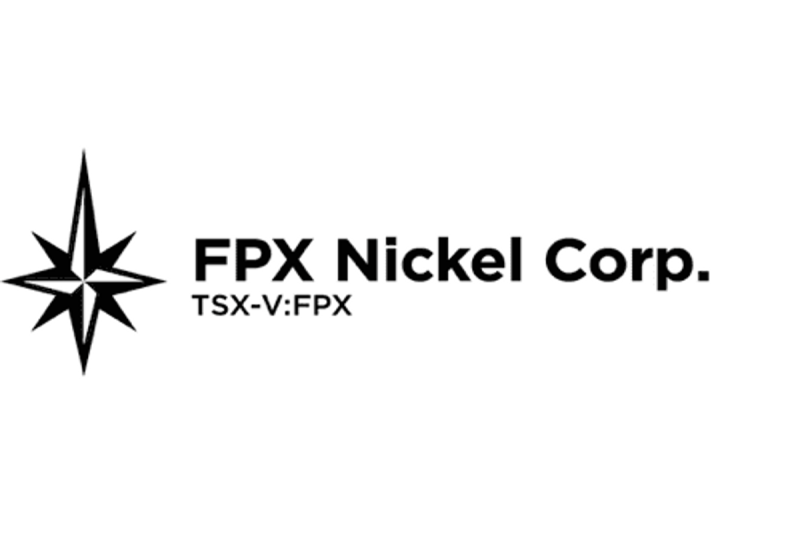
FPX Nickel Produces Battery-Grade Nickel Sulphate and Successfully Completes Pilot-Scale Refinery Testwork
FPX Nickel Corp. (TSXV: FPX) (OTCQB: FPOCF) (‘ FPX ‘ or the ‘ Company ‘) is pleased to announce that it has successfully completed pilot-scale hydrometallurgy refinery testwork and produced battery-grade nickel sulphate from its Baptiste Nickel Project (‘ Baptiste ‘ or the ‘ Project ‘). Following on the Company’s successful 2023 bench-scale hydrometallurgy refining testwork program, the 2024 pilot plant represents a significant step forward in demonstrating the technical maturity of refining Baptiste’s awaruite concentrate. This milestone marks completion of the campaign funded in part by a grant from Natural Resources Canada (‘ NRCan ‘) under the Government of Canada’s Critical Minerals Research, Development and Demonstration (‘ CMRDD ‘) program, which is advancing the commercial readiness of processing technologies to support the development of Canada’s EV battery material supply chain.
Highlights
Successful Pilot-Scale Testwork: Continuous pilot-scale testing of all leaching unit operations confirmed the refinery flowsheet and generated the expected low-impurity leach solution for downstream purification and crystallization testwork Flowsheet Optimization: Testwork has led to flowsheet improvement through the removal of unit operations in the leaching area that proved redundant during continuous, steady-state piloting
‘The results of our hydrometallurgy refinery pilot plant testwork confirm the technical advantages of awaruite nickel mineralization to produce battery-grade nickel sulphate, further demonstrating the opportunity to develop a more streamlined nickel supply chain entirely in Canada ,’ commented Andrew Osterloh , FPX Nickel’s Senior Vice-President, Projects & Operations. ‘Baptiste would represent an almost 50% increase to Canada’s current annual nickel production, all without adding to or displacing any of Canada’s nickel smelting or complex refinery capacity, thereby pioneering a uniquely low-cost, low-carbon link between mining and EV battery production. The results from our pilot plant testwork are currently being incorporated into our Awaruite Refinery Scoping Study, which will contain a detailed evaluation of capital, operating costs and the overall economics of the awaruite refinery; the Study remains on track for completion in the first quarter of 2025.’
Background
As reported in the Company’s news release dated April 30, 2024 , FPX operated a mineral processing pilot plant earlier this year and successfully generated awaruite concentrate to feed a downstream hydrometallurgical refining pilot plant (the ‘ 2024 Hydromet Program ‘). FPX re-engaged Sherritt Technologies Ltd. to conduct the 2024 Hydromet Program, building on Sherritt’s successful completion of the previous bench-scale hydrometallurgical testwork in 2023 (the ‘ 2023 Hydromet Program ‘, described in the Company’s May 17, 2023 news release).
Building on the 2023 Hydromet Program, the 2024 Hydromet Program aimed to further demonstrate the viability of FPX’s refinery flowsheet under pilot-scale and continuous operating conditions. Additionally, the 2024 Hydromet Program also aimed to validate the new ammonia-based purification flowsheet, as discussed in the Company’s news release dated September 16, 2024 .
Hydrometallurgical Refinery Pilot Plant
The 2024 Hydromet Program was conducted in two phases. Phase 1 consisted of continuous, pilot-scale processing of all unit operations in the leaching area as outlined in Figure 2. Phase 2 consisted of batch, bench-scale processing of all unit operations in the purification and crystallization area. A portion of leach solution produced during Phase 1 has been reserved for future continuous, pilot-scale processing of the purification and crystallization area, ensuring the final refinery strategy is supported by purification and crystallization requirements defined in collaboration with FPX Nickel’s downstream partners.
Leaching Area
Continuous, pilot-scale leaching ran for five days and was fed with the high-grade (60% Ni) awaruite concentrate produced during the earlier mineral processing pilot plant. The flowsheet configuration and operating conditions were the same as the 2023 Hydromet Program, with pressure leaching conducted at a moderate temperature (150°C) and pressure (750 kPag). The key performance metrics established at the start of the pilot plant campaign were to obtain high overall nickel and cobalt leach extractions while generating a final leach solution with high nickel and low impurity concentrations.
These key performance metrics are summarized in Table 1, which also presents the basis of the previous economic study (see the Company’s news release dated September 6, 2023 ). In the pressure leach, excellent nickel and cobalt overall leach extractions were achieved at 99.3% and 97.9%, respectively. These high extractions include the unoptimized start-up period, highlighting the robustness of the leach system.
In the atmospheric leach (which utilizes awaruite to neutralize and purify the pressure leach solution), excellent impurity removal was achieved, including the near-complete removal of iron, aluminum, chromium and copper. The final leach solution contained greater than 100 g/L nickel, which is very high by industry standards and will reduce the capital and operating costs for downstream purification and crystallization unit operations. The impurity elements of zinc, manganese, and calcium are all low due to the inherent low concentration of these impurities in Baptiste’s awaruite concentrate.
Table 1 – Leaching area key performance metrics achieved during piloting
Pilot Plant
Results
Previous Study
Basis
Overall Leach Extractions
Nickel (%)
99.3
99.3
Cobalt (%)
97.9
99.5
Final Leach Solution Composition
pH
5.5
>4.5
Nickel (g/L)
104
95
Cobalt (g/L)
2.1
1.5
Magnesium (g/L)
1.6
1.5
Iron (g/L)
Aluminium (g/L)
Chromium (g/L)
Copper (g/L)
Zinc (g/L)
0.01
Manganese (g/L)
0.01
Calcium (g/L)
0.01
In addition to the core leaching operations, the leaching area also includes two smaller circuits to manage build-up of certain trace elements, including copper removal and aluminum/chromium removal. The copper removal circuit, which removes copper by a cementation process, was successfully operated during piloting. Aluminum and chromium were both shown to deport with pressure leach residue, supporting the deletion of this slipstream removal circuit, thereby simplifying the overall leach flowsheet.
Additionally, solid-liquid separation characterization testing was completed on both pressure leach and atmospheric leach residues, with reasonable settling and filtration rates observed for both. These results will inform dewatering equipment sizing and specifications in the ongoing Awaruite Refinery Scoping Study.
Purification and Crystallization
A portion of the bulk solution generated from the leaching area pilot was processed in bench-scale batch testing through cobalt solvent extraction, nickel solvent extraction, and nickel sulphate crystallization. This purification scheme is simpler relative to that required to process other nickel intermediates such as MHP and MSP, with this simplicity made possible by the low impurities contained in, and the neutralization properties of, the awaruite concentrate.
In order to validate the new purification flowsheet developed during Refinery Value Engineering studies (see the Company’s news release dated September 16, 2024 ), solvent extraction operations utilized ammonia as the neutralizing reagent (rather than caustic, which was used in the 2023 Hydromet Program). Along with lower operating costs, the change to an ammonia-based flowsheet allows for the production of an ammonium sulphate byproduct, a valuable fertilizer product, instead of the previous sodium sulphate waste product. The new ammonia-based purification unit operations achieved similar successful performance and results as those achieved during the 2023 Hydromet Program, with the produced crystals (see Figure 1 and Table 2) continuing to meet the strict target specifications for battery applications.
Table 2 – Baptiste Nickel Sulphate Crystal Quality vs. Target Specification
Element
Units
Nickel Sulphate Crystals
Baptiste Testwork
Target Specification 1
Nickel
wt%
>22
>22
Aluminum
ppm
Arsenic
ppm
Calcium
ppm
Cadmium
ppm
Cobalt
ppm
1
Chromium
ppm
Copper
ppm
Iron
ppm
Potassium
ppm
Magnesium
ppm
3
Manganese
ppm
Sodium
ppm
Lead
ppm
Silicon
ppm
Zinc
ppm
3
Note 1: Based on review of industrially available products and battery producers’ requirements
Path Forward
With the completion of the hydrometallurgical testwork reported herein, the Company has completed all testing associated with the CMRDD funding provided by NRCan. Refinery testing results are being incorporated into the ongoing Awaruite Refinery Scoping Study, the results of which will be available in the first quarter of 2025.
Qualified Person
The metallurgical information in this news release has been prepared in accordance with Canadian regulatory requirements set out in National Instrument 43-101: Standards of Disclosures for Minerals Projects of the Canadian Securities Administrators (‘ NI 43-101 ‘). Testwork was supervised, reviewed, and verified by Kyle D. Marte , P.Eng., FPX Nickel’s Principal Metallurgist and a ‘Qualified Person’ as defined by NI 43-101.
About the Baptiste Nickel Project
The Company’s Baptiste Nickel Project represents a large-scale greenfield discovery of nickel mineralization in the form of a sulphur-free, nickel-iron mineral called awaruite (Ni 3 Fe) hosted in an ultramafic/ophiolite complex. The Baptiste mineral claims cover an area of 408 km 2 , west of Middle River and north of Trembleur Lake, in central British Columbia. In addition to the Baptiste Deposit itself, awaruite mineralization has been confirmed through drilling at several target areas within the same claims package, most notably at the Van Target which is located 6 km to the north of the Baptiste Deposit. Since 2010, approximately US $30 million has been spent on the exploration and development of Baptiste.
The Baptiste deposit is located within the territories, keyohs, and consultative boundaries of the Tl’azt’en Nation, Binche Whut’enne, Yekooche First Nation, and Takla Nation .
About FPX Nickel Corp.
FPX Nickel Corp. is focused on the exploration and development of the Decar Nickel District, located in central British Columbia , and other occurrences of the same unique style of naturally occurring nickel-iron alloy mineralization known as awaruite. For more information, please view the Company’s website at https://fpxnickel.com/ or contact Martin Turenne , President and CEO, at (604) 681-8600 or ceo@fpxnickel.com .
On behalf of FPX Nickel Corp.
‘Martin Turenne’
Martin Turenne , President, CEO and Director
Forward-Looking Statements
Certain of the statements made and information contained herein is considered ‘forward-looking information’ within the meaning of applicable Canadian securities laws. These statements address future events and conditions and so involve inherent risks and uncertainties, as disclosed in the Company’s periodic filings with Canadian securities regulators. Actual results could differ from those currently projected. The Company does not assume the obligation to update any forward-looking statement.
Neither the TSX Venture Exchange nor its Regulation Services Provider accepts responsibility for the adequacy or accuracy of this release.
SOURCE FPX Nickel Corp.
View original content to download multimedia: http://www.newswire.ca/en/releases/archive/October2024/15/c8741.html
News Provided by Canada Newswire via QuoteMedia
